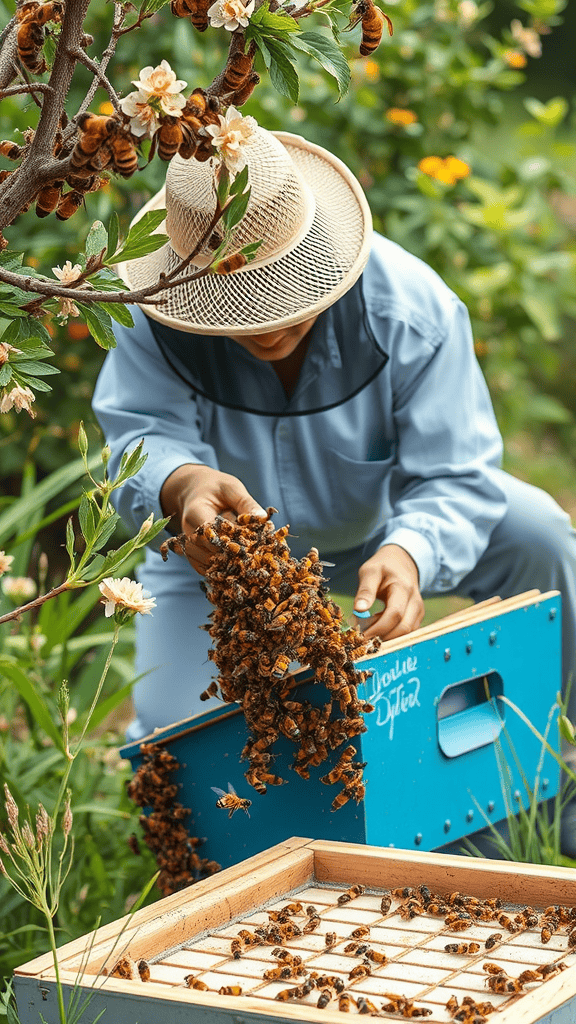Essential Steps for Starting Bee Farming in Texas
Starting bee farming in Texas can be an exciting and rewarding venture. With the state’s suitable climate and diverse floral resources, you can create a thriving apiary that benefits not only you but also the environment. Here are essential steps to guide you in your journey.
Understand Local Regulations
Before you begin your bee farming journey, check with local authorities about any regulations or zoning laws applicable to beekeeping. In Texas, beekeeping is generally supported, but checking with local ordinances will help you avoid any legal issues. Additionally, some counties might have specific registration requirements for beekeepers.
Learn the Basics of Beekeeping
Before investing in equipment or bees, take the time to educate yourself about beekeeping. Consider enrolling in local beekeeping classes or workshops. Books and online resources can also provide valuable information about bee behavior, hive management, and seasonal requirements. The knowledge gained will lay a strong foundation for your future beekeeping endeavors.
Select the Right Bees
Choosing the right bee species is crucial for your success. In Texas, the Italian honey bee is a popular choice due to its gentle behavior, good honey production, and adaptability to climate conditions. You may also consider Carniolan or Russian honey bees, each having unique characteristics. Buy your bees from reputable local suppliers or established beekeeping associations to ensure healthy and disease-free stock.
Choose a Suitable Location
Your bees need a suitable environment to thrive. Select a location that offers:
- Plentiful nectar and pollen sources, such as flowering trees and wildflowers.
- Shade during the hottest part of the day to help regulate hive temperature.
- Protection from strong winds and harsh weather.
- Easy access for you to manage the hives.
Invest in Essential Equipment
Equip yourself with the necessary tools and gear for beekeeping. Essential equipment includes:
- Beehives: Langstroth hives are the most common choice for beginners.
- Protective clothing: Use a bee suit, gloves, and a veil to protect yourself.
- Tools: Get a smoker, hive tool, and bee brush for effective hive management.
- Honey extraction equipment: A honey extractor and storage containers are vital when harvesting honey.
Start with One or Two Hives
As a beginner, start with one or two hives to learn the basics without feeling overwhelmed. This smaller scale allows you to become familiar with the daily management of the bees, monitor their health, and practice responsible beekeeping techniques. As you gain confidence and knowledge, you can gradually expand your hive numbers.
Monitor Hive Health Regularly
Consistent monitoring of your hives is essential. Check for signs of disease, pests, and stress. Look for symptoms like mite infestations or signs of a failing queen. Keeping detailed records of hive inspections and changes helps you make informed decisions. You can maintain healthy hives by ensuring proper ventilation and adequate food stores, especially during the winter months.
Join a Local Beekeeping Club
Beekeeping can sometimes feel lonely, but joining a local beekeeping club offers support and camaraderie. These clubs are an excellent resource for networking, sharing experiences, and learning from seasoned beekeepers in your area. Participating in local events can enhance your skills and deepen your passion for bee farming.
Harvesting Honey
After your bees have established themselves and produced surplus honey, it’s time to harvest. Timing is crucial; wait until the frames are at least 80% capped before extracting honey. Use a honey extractor to ensure you’re getting the most out of your harvest while being gentle on the bees. Always leave enough honey in the hive for the bees to sustain themselves.
Continue Learning and Adapting
As you progress in your bee farming journey, it’s important to continue learning. Stay updated on best practices, emerging diseases, and new technologies in beekeeping. Experiment with different hive techniques and floral resources to optimize your setup. Adaptability is key to long-term success in bee farming.
With proper planning and dedication, you can succeed in bee farming in Texas. Following these essential steps will help you create a productive apiary while also contributing to the health of the environment.
Understanding the Benefits and Challenges of Beekeeping in Texas
Beekeeping in Texas can be a rewarding endeavor, offering various benefits while posing some challenges. Understanding these can help you decide whether this agricultural pursuit is right for you.
One of the primary benefits of beekeeping is the crucial role bees play in pollination. Texas is home to diverse flora and fauna, contributing to robust agricultural production. By keeping bees, you can help enhance the pollination of local crops, fruits, and vegetables, improving yields for both you and your community. This cooperative interaction not only supports agriculture but also strengthens the ecosystem.
Another significant advantage is the production of honey. Texas offers a unique environment for different honey varieties, such as wildflower, sage, and mesquite. Not only will you get to enjoy the fruits of your labor, but you can also sell your honey at local markets or online, generating additional income. Plus, honey has health benefits and is a popular natural sweetener, increasing its demand.
Beekeeping also encourages a closer connection to nature. Spending time with bees can be meditative and fulfilling. As you learn about their behavior and lifecycle, you will deepen your understanding of these fascinating creatures. This knowledge can promote environmental stewardship, making you an advocate for biodiversity.
However, keeping bees in Texas comes with its share of challenges. One common issue is the fluctuating climate. The state experiences extreme weather, including droughts, heavy rains, and intense heat. Bees are sensitive to these conditions; prolonged drought can lead to fewer flowers, reducing food availability for your hives. Effective management strategies, such as feeding your bees during dry spells, are crucial in mitigating these effects.
Another challenge is pests and diseases. Varroa mites, for instance, are a significant threat to bee populations. These parasites attach to bees and can severely weaken hives if left unchecked. To combat this, regular inspections and treatments are necessary. Education resources and local beekeeping groups can provide valuable support in learning how to monitor and manage these challenges effectively.
In addition, beekeeping requires continuous learning and adaptation. There are regulations and best practices to follow, especially regarding hive management and safety measures. Joining local beekeeping associations can be beneficial. These organizations offer workshops and mentorship opportunities, which can guide new beekeepers through the complexities of their journey.
Understanding the local ecosystem is essential for successful beekeeping in Texas. Different regions of the state offer varying floral resources, which can impact honey production and bee health. As a prospective beekeeper, familiarizing yourself with native plants can greatly benefit your hives. Planting bee-friendly flowers around your home can also provide additional food sources for your bees.
If you’re considering starting a beekeeping venture in Texas, here are some essential steps to follow:
- Research and Education: Start with reading books, attending workshops, or joining a local beekeepers’ group.
- Understand Local Regulations: Before getting started, familiarize yourself with Texas beekeeping laws and zoning regulations.
- Select Your Equipment: Invest in quality beekeeping tools, including protective gear, a hive, and necessary tools for maintenance.
- Choose Your Bee Species: Research different bee species suitable for your region, such as Italian or Russian bees.
- Setting Up Your Hive: Find a suitable location for your hive that offers sunlight, shelter, and access to flowers.
- Regular Maintenance: Conduct routine inspections to check for pests, diseases, and the general health of your colony.
Beekeeping in Texas can be a fulfilling pursuit that benefits you and the environment. While challenges exist, they are not insurmountable. With dedication, education, and community support, you can successfully manage your hives and contribute to the vibrant ecosystem around you.
Conclusion
Starting bee farming in Texas is an exciting journey filled with opportunity and rewards. By following the essential steps—researching local regulations, choosing the right equipment, and understanding the local bee species—you lay a strong foundation for a successful beekeeping venture. Familiarizing yourself with the plants in your area will help to ensure your bees have ample resources for foraging.
While there are numerous benefits to beekeeping, such as honey production and pollination support for local ecosystems, it’s crucial to acknowledge the challenges as well. Texas weather can be unpredictable, and pests or diseases may threaten your hives. Additionally, beekeeping requires a commitment of time and effort. However, for those who are passionate and willing to learn, the rewards often outweigh these challenges.
Engaging with local beekeeping associations, attending workshops, and connecting with experienced beekeepers can further enhance your journey. Sharing knowledge and experiences within the community not only aids in overcoming challenges but also enriches your beekeeping experience.
Ultimately, starting bee farming in Texas allows you to contribute positively to the environment while enjoying the sweet rewards of your labor. With careful planning and ongoing education, you can cultivate a vibrant hive that plays a vital role in both agricultural health and biodiversity. Embrace the adventure, and let your passion for beekeeping flourish in the heart of Texas.
As an Amazon Associate, I earn from qualifying purchases.

